
Intensive pig farming, also known as pig factory farming, is the primary method of pig production, in which grower pigs are housed indoors in group-housing or straw-lined sheds, whilst pregnant sows are housed in gestation crates or pens and give birth in farrowing crates.

Vietnamese Pot-bellied is the exonym for the Lon I or I pig, an endangered traditional Vietnamese breed of small domestic pig.
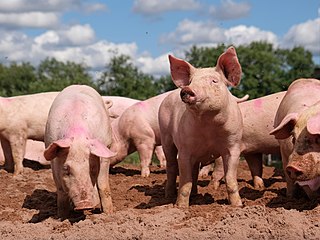
The pig, often called swine, hog, or domesticpig when distinguishing from other members of the genus Sus, is an omnivorous, domesticated even-toed ungulate. It is variously considered a subspecies of the Eurasian boar or a distinct species, but the American Society of Mammalogists considers it the latter. The pig's head-plus-body length ranges from 0.9 to 1.8 m, and adult pigs typically weigh between 50 and 350 kg, with well-fed individuals even exceeding this range. The size and weight of hogs largely depends on their breed. Compared to other artiodactyls, a pig's head is relatively long and pointed. Most even-toed ungulates are herbivorous, but pigs are omnivores, like their wild relative. Pigs "grunt" and make "snorting" sounds.

The American Yorkshire, a breed of domestic pig, is the American version of the English Yorkshire. The American Yorkshire has smaller and more-floppy ears when compared to the English Yorkshire's large, erect ears. American Yorkshires are the most recorded swine breed farmed for its meat in the United States.

The Essex is a breed of domestic pig originating in the United Kingdom.

The Berkshire is a British breed of pig. It originated in the English county of Berkshire, for which it is named. It is normally black, with some white on the snout, on the lower legs, and on the tip of the tail.
Boar taint is the offensive odor or taste that can be evident during the cooking or eating of pork or pork products derived from non-castrated male pigs once they reach puberty. Boar taint is found in around 20% of entire male finishing pigs. Skatole may also be detected in gilts, but this is linked with faecal contamination of the skin. Studies show that about 75% of consumers are sensitive to boar taint, leading pork producers to control this in order to maximise profits.
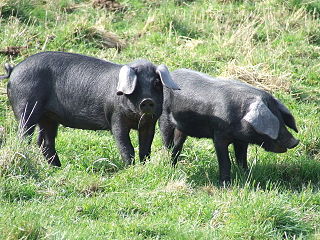
The Large Black pig is a British breed of domestic pig. It is the only British pig that is entirely black. It was created in the last years of the nineteenth century by merging the black pig populations of Devon and Cornwall in the south-west with those of Essex, Suffolk and Kent in the south-east. It is hardy, docile and prolific; it forages well and is suitable for extensive farming, but not well suited to intensive management.

Pig farming or hog farming is the raising and breeding of domestic pigs as livestock, and is a branch of animal husbandry. Pigs are farmed principally for food and skins.

The Mangalica is a Hungarian breed of domestic pig. It was developed in the mid-19th century by crossbreeding Hungarian breeds from Nagyszalonta and Bakony with the European wild boar and the Serbian Šumadija breed. The Mangalica pig grows a thick, curly coat of hair. The only other pig breed noted for having a long coat is the extinct Lincolnshire Curly Coat pig of England.
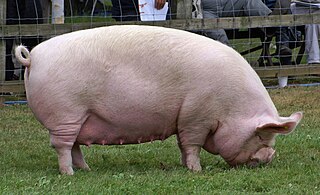
The Middle White is a British breed of domestic pig. It originated in Yorkshire, and derived from the Large White and the now-extinct Small White. It was recognised in 1852, and the first herd-book was published in 1884. It is a porker, reared for fresh pork, and is characterised by a short and sharply-upturned snout. After the Second World War it came close to extinction; although numbers have recovered somewhat, it is listed by the Rare Breeds Survival Trust as "priority" – the highest level of risk.

The Welsh is a breed of domestic pig native to Wales. It is a large white breed known for its hardiness in outdoor (extensive) farming, its long, pear-shaped body and its lop-ears. The breed was first mentioned in the 1870s, and after the Howitt committee report in 1955, became the third most common sire in the United Kingdom after the Large White pig and British Landrace pig. The Welsh pig experienced a decline in numbers in the late twentieth century because consumer demands had changed and the carcase was considered too fatty. In 2005 the breed was considered endangered and later came under the auspices of the Rare Breeds Survival Trust. Since then numbers have expanded somewhat, and by 2012, the registered breeding herd had increased to over 1000 animals.
The Cumberland was a breed of domestic pig that originated in the North of England; it was used to produce local delicacies like the Cumberland sausage and Cumberland ham. The breed became extinct in 1960, after changes in farming methods and a demand for less fatty meat led to it falling out of favour.
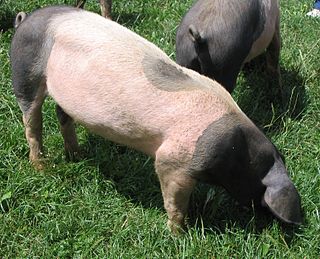
The Swabian-Hall swine is a breed of domestic pig originating from Schwäbisch Hall in Baden-Württemberg, Germany. It is a large pig, white in the centre with a black head and rear and narrow grey bands at the transition from white to black skin. They have large litters averaging more than nine piglets.

Bacon and Hams is a 1917 book by George J. Nicholls, a member of the Institute of Certificated Grocers. The book details the then-modern bacon and ham industry beginning with the use of the pig breeds, meat processing and the distribution and pricing of cuts with a focus on the United Kingdom. The meat processing aspects focus on the popular Wiltshire cut of the time, but also includes American cuts as well. The book was described, with approbation, by the Saskatchewan Overseas Livestock Marketing Commission, as an "admirable and important treatise". Despite having entered the public domain, the book is rare and collectible and generated interest for its "unparalleled" anatomical details of pigs found in its fold-out pages.
Pork in Ireland has been a key part of the Irish diet since prehistory. Ireland's flora and fauna overwhelmingly arrived via a Neolithic land bridge from Great Britain prior to its submerging around 12,000 BP. When the very first hunter-gatherers arrived around 2,000 years later, the local ecosystem largely resembled that of modern Ireland.
The Lacombe is a breed of domestic pig native to Canada. Named for the Lacombe Research and Development Centre in Lacombe, Alberta, the breed was the first strain of livestock developed in the country.
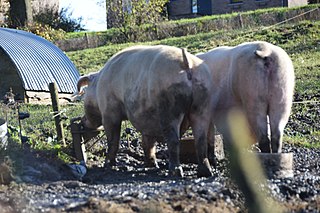
The Belgian Landrace, also known as the Improved Belgian, Belgian Improved Landrace, and the Belgian Lop-eared, is a breed of domestic pig from northern Belgium. It was created from importing English breeds and improving them until they were "graded up" to the German Improved Landrace from 1930 to 1945 and then breeding them with the Dutch Landrace in 1945. Other breeds were also incorporated into the bloodline to strengthen it, such as with ones from Luxembourg in 1955, Germany in 1971, and the Czech Republic in 1974. Used in many different countries, the Belgian Landrace is also one of the "four major commercial breeds" in France.
The Dutch Landrace pig is a standardized breed of domestic pig originating in the Netherlands. The breed was developed from the native landrace of pigs of the area, crossbred with strains from neighboring counties. The Dutch Landrace is considered "a meaty and efficient breed". The breed is unusually responsive to the halothane test, which can be used to weed out individuals with low projected survivability and meat production.
The Large White Ulster, or Ulster White, was a breed of domestic pig. Primarily bred for bacon production, it was the favoured breed of farmers in the north of Ireland up until the mid 20th century.
















